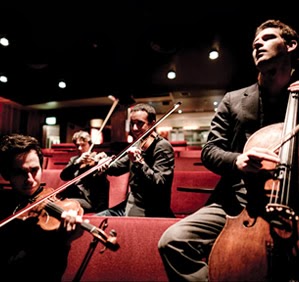Ebene Quartet brings three distinctive major works here on its 20-concert, 25-day tour

The Ebene String Quartet' s return visit under Ensemble Music Society auspices Wednesday night confirmed the excellence that the four Frenchmen exhibited here in 2011. The Ebene Quartet made its second appearance here Wednesday. Each of the works performed is highly characteristic (yet boundary-stretching) of its composer, ranging from the adventurous harmonies of Mozart's Quartet in E-flat, K. 428, on through Mendelssohn's weighty String Quartet in A minor, op. 13, No. 2, to Robert Schumann's controlled-bipolar Quartet in A major, op. 41, no. 3. Starting with the Schumann, which had the second half of the program at Indiana History Center to itself, the Ebene Quartet exemplified the French virtues of clarity and order. That didn't keep them from emphasizing the German composer's skill at projecting the two contrasting sides of his personality, however. The daydreaming first-movement themes, for example, are at times supported by lightly agitated acco













